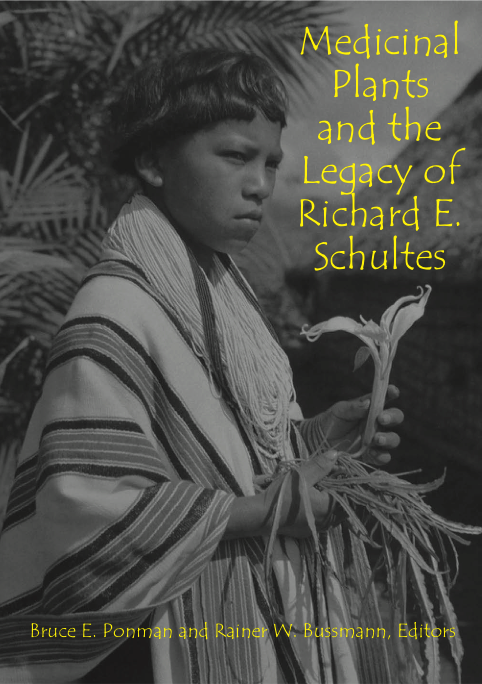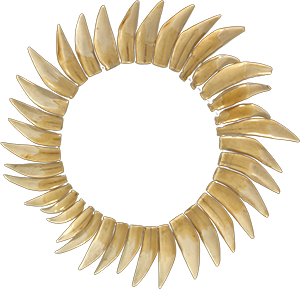The Lost Amazon: The Photographic Journey of Richard Evans Schultes
by Wade Davis
HerbalGram. 2005; 66:50-59 American Botanical Council
In the following pages we feature some of the exquisite photography from the new book, The Lost Amazon: The Photographic Journey of Richard Evans Schultes. These photos were taken by Schultes, the late Harvard professor and reputed "father of Ethnobotany," during the 12 years he spent cataloguing rubber trees and medicinal and psychoactive plants in the Amazon during the 1940s and 1950s. His exploits in the Amazon have been detailed in the superlative book, One River—Exploration and Discoveries in the Amazon Rainforest (Touchstone, 1996). Both The Lost Amazon and One River were written by one of Schultes most accomplished students, the eminent author and ethnobotanist, Wade Davis, currently an explorer-in-residence at the National Geographic Society. (Excerpts from One River were published in HerbalGram 38.) Portions of the text of One River are found in The Lost Amazon.
Schultes shot with a 1927-era twin lens Rolleiflex, and Davis writes that this type of camera influenced Schultes's composition and the resulting photographs. These images show an Amazon and its cultures before they were lamentably encroached upon by modernization and the influences of the twentieth and twenty-first centuries.
To set the context for Schultes's photographs, we have excerpted the following text from the preface of The Lost Amazon; also reprinted from the book are the captions that accompany each photo. We are deeply grateful to Dr. Davis and Chronicle Books for allowing us to share these writings and images with our readers. Profits from book sales go to Dorothy Schultes. — Editor
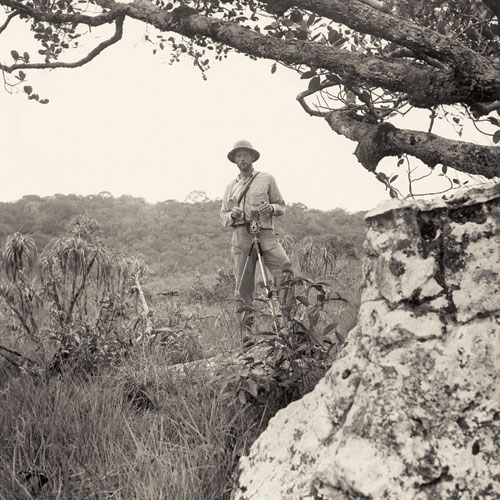
Dr. Schultes at Savannah of Yapobodá, Río Kuduyari, Vaupés, 1946. Photo courtesy Wade Davis and Chronicle Books.
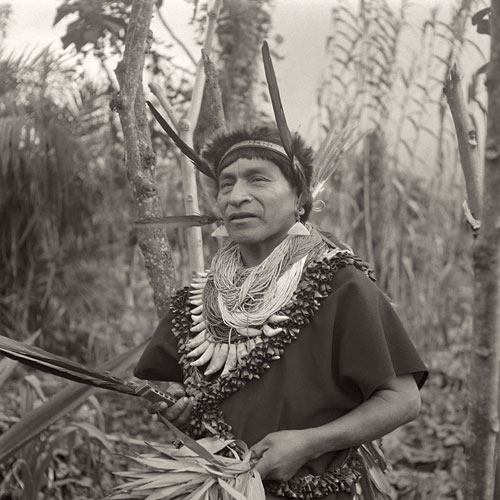
Traditional Healer Salvador Chindoy. Schultes's main informant in Sibundoy was a traditional healer named Salvador Chindoy.
In photographs, Salvador is almost always singing or leaning over a patient as he sweeps away illness with a fan of jungle leaves. He wears a black cushma tied at the waist, a necklace of jaguar teeth, pounds of glass beads, a magnificent corona with a halo of erect macaw feathers, and a long cape of parrot feathers that hangs down his back to the waist. His ears are pierced by the tail feathers of a scarlet macaw, and his wrists are often decorated with leaves. The entire costume is a walking vision. The beads and feathers, the sweet leaves on his arms, and the delicate motifs painted onto his face are a conscious and deliberate attempt to emulate the elegant dress of the spirit people who the shaman meets when he ingests yagé. Photo courtesy Wade Davis and Chronicle Books.
In photographs, Salvador is almost always singing or leaning over a patient as he sweeps away illness with a fan of jungle leaves. He wears a black cushma tied at the waist, a necklace of jaguar teeth, pounds of glass beads, a magnificent corona with a halo of erect macaw feathers, and a long cape of parrot feathers that hangs down his back to the waist. His ears are pierced by the tail feathers of a scarlet macaw, and his wrists are often decorated with leaves. The entire costume is a walking vision. The beads and feathers, the sweet leaves on his arms, and the delicate motifs painted onto his face are a conscious and deliberate attempt to emulate the elegant dress of the spirit people who the shaman meets when he ingests yagé. Photo courtesy Wade Davis and Chronicle Books.

A Young Seringuero, Río Loretoyacu, Colombian Amazon Throughout the fall of 1944, and during the subsequent tapping seasons of 1945 and 1946, Schultes came to know the natural history of rubber trees through the eyes of the seringueros, the rubber tappers who entered the forest at dawn to begin the arduous task of gathering latex from hundreds of widely scattered trees. Schultes surveyed some 120,000 individual trees, monitoring the yields of 6,000 of the best, and from these selected 120 clones to be dispatched as budwood for propagation at research stations in Costa Rica. Photo courtesy Wade Davis and Chronicle Books.
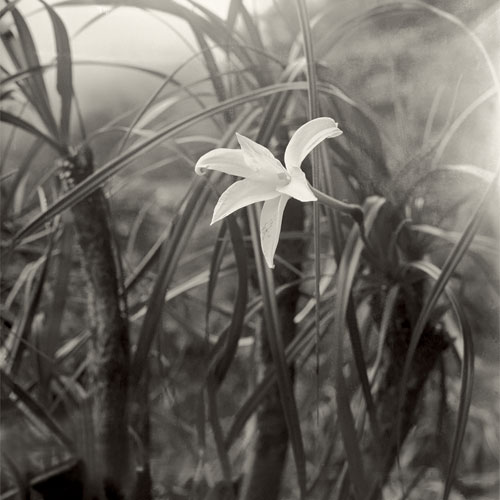
Vellozia phantasmagoria A new species discovered May 14, 1943, and later named by Schultes. Chiribiquete, Río Apaporis. Photo courtesy Wade Davis and Chronicle Books.
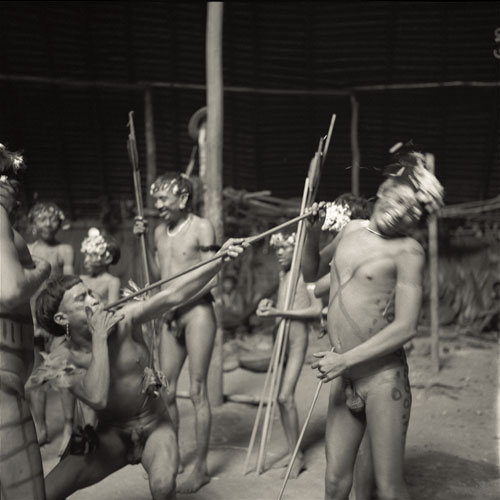
In the summer of 1967, Schultes traveled to the upper Río Negro in Brazil and experienced for the first time the powerful psychoactive effects of ebéna, the powder known to the Yanomami, or Waiká, as the Semen of the Sun. The powder induced not the distortion of reality, but rather its dissolution. In that suspended state of consciousness, the healers worked their deeds of mystical and medical rescue. Photo courtesy Wade Davis and Chronicle Books.
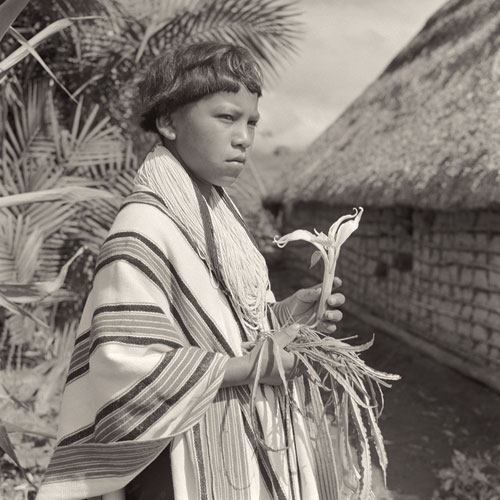
Kamsá Youth with the blossom of Culebra Borrachera, Sibundoy, June 1953. The tree daturas are among the most dangerous and toxic of all psychoactive plants. They contain tropane alkaloids that, though useful in the treatment of asthma, can in higher dosage induce a frightening state of psychotic delirium marked by burning thirst, nightmarish visions, a sensation of flight, and ultimately stupor and death. As true cultivars, these plants are always found in association with human habitation, in the domain of the shamanic healer. Years of artificial selection have produced numerous varieties, including this curious form known to the Kamsá as either the jaguar's intoxicant or culebra borrachera, the "drunken snake.” When Schultes first encountered the plant in 1941, he thought it so unusual that he recognized it as a new genus, which he named Methysticodendron amesianum in honor of his Harvard professor Oakes Ames. Photo courtesy Wade Davis and Chronicle Books.
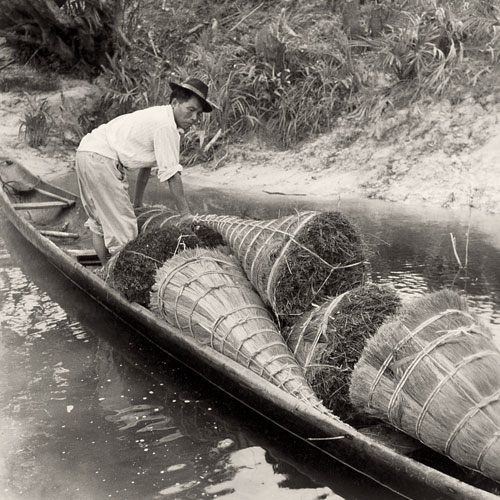
Transporting piassaba fiber, Río Guainía, Vaupés. The piassaba palm thrives only on the white sands of the open savannahs of the upper Río Negro. Though mostly used for brushes and brooms, piassaba was so highly valued that men risked their lives to transport it from the headwaters a thousand miles or more in dugout canoes through impossible rapids to the markets of Manaus. Photo courtesy Wade Davis and Chronicle Books.
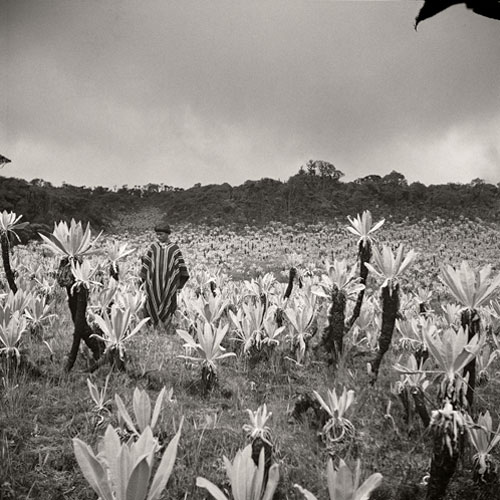
A Kamsá Youth on the Páramo of San Antonio above the Valley of Sibundoy, November 1941. Photo courtesy Wade Davis and Chronicle Books.
Between 1941 and 1953, in twelve years of almost continuous fieldwork in the Northwest Amazon, Schultes took hundreds of photographs, mostly of plants but also of scenes and moments that captured his imagination. These he filed away, placing each negative in a small envelope and gluing a two-inch square print to the upper left-hand corner on the outside. On the envelope itself he wrote a short caption and noted the date the picture was taken. This vast archive he stored in two metal boot lockers, out of sight and, in time, out of mind in the basement office of his home in suburban Boston.
Between 1941 and 1953, in twelve years of almost continuous fieldwork in the Northwest Amazon, Schultes took hundreds of photographs, mostly of plants but also of scenes and moments that captured his imagination. These he filed away, placing each negative in a small envelope and gluing a two-inch square print to the upper left-hand corner on the outside. On the envelope itself he wrote a short caption and noted the date the picture was taken. This vast archive he stored in two metal boot lockers, out of sight and, in time, out of mind in the basement office of his home in suburban Boston.
The design of the camera [a 1927-era twin lens Rolleiflex] also determined how a picture had to be taken. This proved to be of vital significance both artistically and in terms of how the Indians responded to the photographic moment. The point of view of a Rolleiflex is not at eye level, as in the case of modern single lens reflex cameras, but rather at the height of the waist. Schultes stood well over six feet tall. The Amazonian Indians are generally of low stature. Rather than towering over his subjects, he tended to photograph from below, a perspective that enhanced the dramatic presence of the individuals.
In a more symbolic sense, the Rolleiflex by definition demanded that the photographer in composing and exposing an image literally bow to the subject of the photograph, a gesture that in the setting of the Amazon, with its history of Indians being violated and abused, transformed the photographic act from one of aggression to one of engagement and humility.
Henri Cartier-Bresson wrote that great photographs come about in that fraction of a second when the head, heart and eye find perfect alignment in an axis of the spirit. The photographs in this book clearly reveal the precision of Schultes's vision, the breadth of his mind and imagination, the reach of his spirit and most important of all, the size of his heart, as expansive and all embracing as the forest he loved so dearly.
Having slipped away from the confines of his own world, he [Schultes] experienced through multiple lens, his eyes, the delicately honed glass of his camera, the visionary realm of the magic plants, an exotic land on the cusp of change. He was the right person in the right place at the right time to accomplish greatness and leave in his wake a remarkable photographic legacy.
His very best photographs have a timeless, ethereal, even transcendent quality, as if inspired and envisioned by a completely different person.
His own favorite is a portrait of a young Kamsá boy holding the leaves and blossom of a tree known as the jaguar's intoxicant. The boy is dressed in a white woolen poncho with broad stripes. His skin appears soft and unblemished. His thick black hair has been cut with a bowl. His only adornment is a mound of necklaces of small white and dark glass beads. His expression is completely natural. He neither fears the camera nor is he concerned about its disapproval. He has the freshness and ease of a photographic subject who has never seen himself in a photograph. Neither sentimental nor condescending, the image is touched with pathos. It is as if in taking the photograph, in freezing that moment of the boy's life, Schultes was both testifying to the youth's vulnerability and mortality, and bearing witness to the relentless corrosion of time.
There was always something of the avatar in Schultes. Even as he looked back to those who had inspired him, most notably the nineteenth century English botanist Richard Spruce whose seventeen year sojourn in the Amazon surpassed even his own, he looked forward to those who would inherit his mantle. As a teacher he understood in his wisdom that the student was as important as the teacher in the lineage of knowledge. His circle of acolytes reached far beyond the walls of Harvard, his academic home for all of his professional life. In a teaching career that spanned decades he touched and transformed dozens of lives.
Although proud of his many botanical discoveries, Schultes was not one to speak of them, and it would never have occurred to him to place his work in a historical context. His capacity for introspection was limited. A man of action and deed, he shunned publicity, and was as far removed from the pop culture of his day as a medieval herbalist. His reference points were not of his century.
In his last years, according to his wife Dorothy, he kept the book [One River] on his bedside table and, when he could not sleep at night, he would open it randomly and read of his life. Not long before he died, he took me aside, and pointing to some dialogue in the text, said, "Did I ever tell you what Mrs. Bedard said to me when I first met her in 1943? Look it's right here!"
I found this both amusing and very touching. Here after all was the man who had made my life possible. Now the book had become his life. His life had become my imagination, and my imagination had breathed meaning and content back into the life of an old man who was slowly fading away as all old men must inevitably do.
From the book: THE LOST AMAZON, the Photographic Journey of Richard Evans Schultes, by Wade Davis, 2004 ©. Used with permission of Chronicle Books LLC, San Francisco, CA. Visit www.chroniclebooks.com
In a more symbolic sense, the Rolleiflex by definition demanded that the photographer in composing and exposing an image literally bow to the subject of the photograph, a gesture that in the setting of the Amazon, with its history of Indians being violated and abused, transformed the photographic act from one of aggression to one of engagement and humility.
Henri Cartier-Bresson wrote that great photographs come about in that fraction of a second when the head, heart and eye find perfect alignment in an axis of the spirit. The photographs in this book clearly reveal the precision of Schultes's vision, the breadth of his mind and imagination, the reach of his spirit and most important of all, the size of his heart, as expansive and all embracing as the forest he loved so dearly.
Having slipped away from the confines of his own world, he [Schultes] experienced through multiple lens, his eyes, the delicately honed glass of his camera, the visionary realm of the magic plants, an exotic land on the cusp of change. He was the right person in the right place at the right time to accomplish greatness and leave in his wake a remarkable photographic legacy.
His very best photographs have a timeless, ethereal, even transcendent quality, as if inspired and envisioned by a completely different person.
His own favorite is a portrait of a young Kamsá boy holding the leaves and blossom of a tree known as the jaguar's intoxicant. The boy is dressed in a white woolen poncho with broad stripes. His skin appears soft and unblemished. His thick black hair has been cut with a bowl. His only adornment is a mound of necklaces of small white and dark glass beads. His expression is completely natural. He neither fears the camera nor is he concerned about its disapproval. He has the freshness and ease of a photographic subject who has never seen himself in a photograph. Neither sentimental nor condescending, the image is touched with pathos. It is as if in taking the photograph, in freezing that moment of the boy's life, Schultes was both testifying to the youth's vulnerability and mortality, and bearing witness to the relentless corrosion of time.
There was always something of the avatar in Schultes. Even as he looked back to those who had inspired him, most notably the nineteenth century English botanist Richard Spruce whose seventeen year sojourn in the Amazon surpassed even his own, he looked forward to those who would inherit his mantle. As a teacher he understood in his wisdom that the student was as important as the teacher in the lineage of knowledge. His circle of acolytes reached far beyond the walls of Harvard, his academic home for all of his professional life. In a teaching career that spanned decades he touched and transformed dozens of lives.
Although proud of his many botanical discoveries, Schultes was not one to speak of them, and it would never have occurred to him to place his work in a historical context. His capacity for introspection was limited. A man of action and deed, he shunned publicity, and was as far removed from the pop culture of his day as a medieval herbalist. His reference points were not of his century.
In his last years, according to his wife Dorothy, he kept the book [One River] on his bedside table and, when he could not sleep at night, he would open it randomly and read of his life. Not long before he died, he took me aside, and pointing to some dialogue in the text, said, "Did I ever tell you what Mrs. Bedard said to me when I first met her in 1943? Look it's right here!"
I found this both amusing and very touching. Here after all was the man who had made my life possible. Now the book had become his life. His life had become my imagination, and my imagination had breathed meaning and content back into the life of an old man who was slowly fading away as all old men must inevitably do.
From the book: THE LOST AMAZON, the Photographic Journey of Richard Evans Schultes, by Wade Davis, 2004 ©. Used with permission of Chronicle Books LLC, San Francisco, CA. Visit www.chroniclebooks.com
